

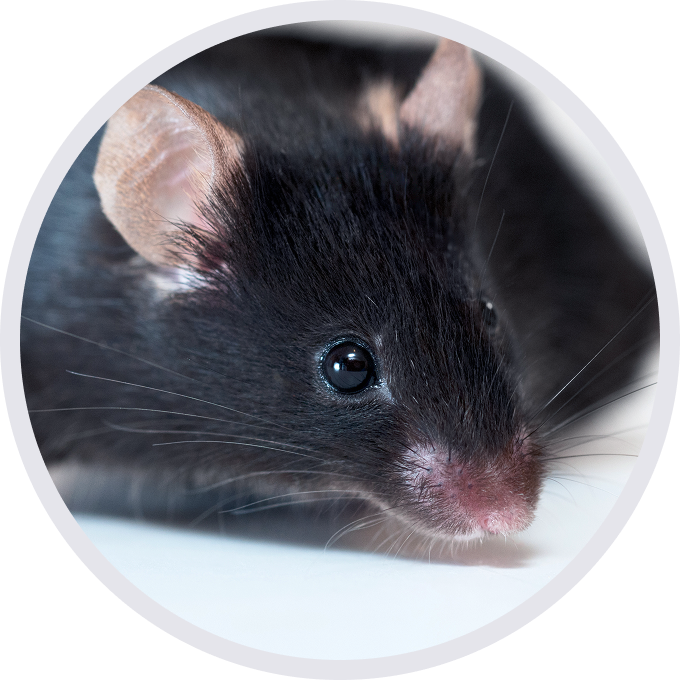
C57BL/6N-Tnfrsf25tm3(TNFRSF25)Bcgen/Bcgen • 113926
| Product name | B-hDR3 mice |
|---|---|
| Catalog number | 113926 |
| Strain name | C57BL/6N-Tnfrsf25tm3(TNFRSF25)Bcgen/Bcgen |
| Strain background | C57BL/6N |
| NCBI gene ID | 8718 (Human) |
| Aliases | APO-3, DDR3, DR3, GEF720, LARD, PLEKHG5, TNFRSF12, TR3, TRAMP, WSL-1, WSL-LR |
Gene targeting strategy for B-hDR3 mice. The exons 1-10 of mouse Dr3 gene that encode the whole molecule (ATG to STOP codon), including promoter, 5’UTR and 3’UTR were replaced by human counterparts in B-hDR3 mice. The human DR3 expression was driven by human DR3 promoter, while mouse Dr3 gene transcription and translation will be disrupted.
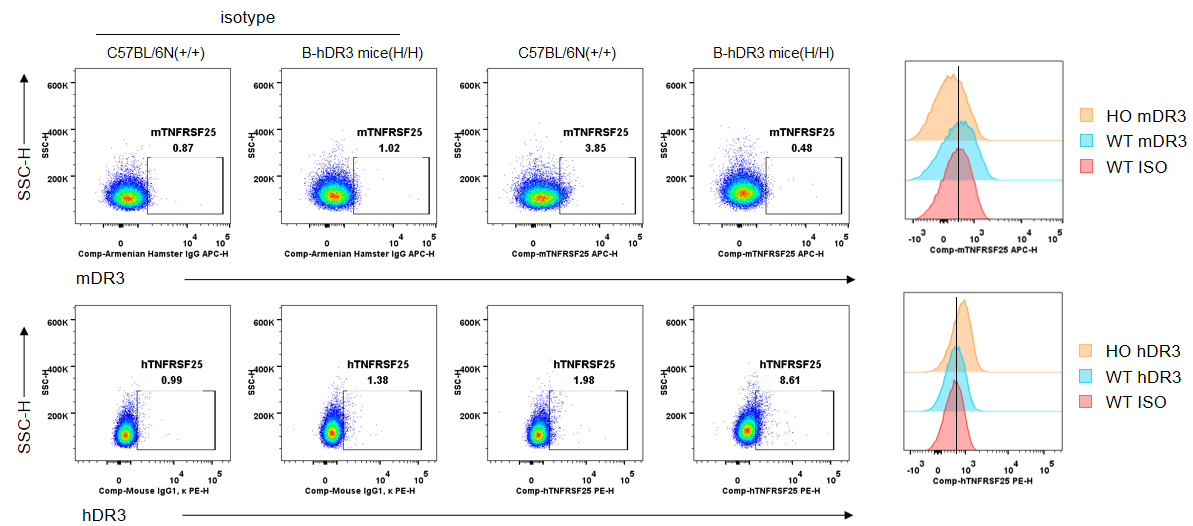
Strain specific DR3 expression analysis in wild-type C57BL/6N mice and homozygous B-hDR3 mice by flow cytometry. Splenocytes were collected from wild-type C57BL/6N mice(+/+) and homozygous B-hDR3 mice(H/H), protein expression was analyzed with anti-mouse DR3 antibody (Biolegend, 144407) and anti-human DR3 antibody (Biolegend, 307105) by flow cytometry. Mouse DR3 was detectable in wild-type C57BL/6N mice, human DR3 was detectable in homozygous B-hDR3 mice.

Strain specific DR3 expression analysis in wild-type C57BL/6N mice and homozygous B-hDR3 mice by flow cytometry. Splenocytes were collected from wild-type C57BL/6N mice(+/+) and homozygous B-hDR3 mice(H/H), protein expression was analyzed with anti-human DR3 antibody Ab1 provided by the client. Human DR3 was only detectable in homozygous B-hDR3 mice.
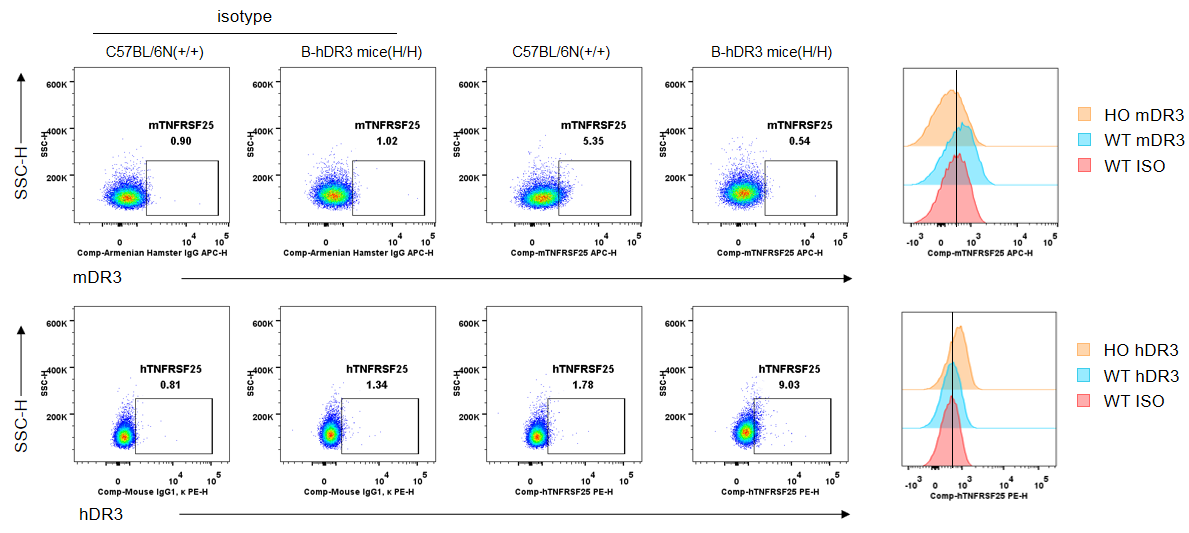
Strain specific DR3 expression analysis in wild-type C57BL/6N mice and homozygous B-hDR3 mice by flow cytometry. Splenocytes were collected from wild-type C57BL/6N mice(+/+) and homozygous B-hDR3 mice(H/H), protein expression was analyzed with anti-mouse DR3 antibody (Biolegend, 144407) and anti-human DR3 antibody (Biolegend, 307105) by flow cytometry. Mouse DR3 was detectable in wild-type C57BL/6N mice, human DR3 was detectable in homozygous B-hDR3 mice.

Strain specific DR3 expression analysis in wild-type C57BL/6N mice and homozygous B-hDR3 mice by flow cytometry. Splenocytes were collected from wild-type C57BL/6N mice(+/+) and homozygous B-hDR3 mice(H/H), protein expression was analyzed with anti-human DR3 antibody Ab1 provided by the client. Human DR3 was only detectable in homozygous B-hDR3 mice.
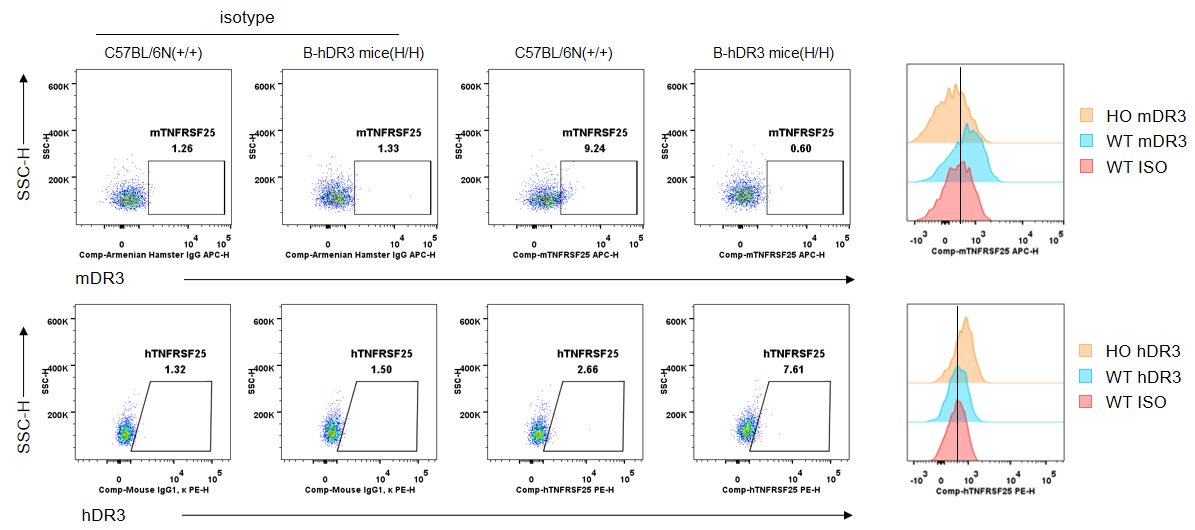
Strain specific DR3 expression analysis in wild-type C57BL/6N mice and homozygous B-hDR3 mice by flow cytometry. Splenocytes were collected from wild-type C57BL/6N mice(+/+) and homozygous B-hDR3 mice(H/H), protein expression was analyzed with anti-mouse DR3 antibody (Biolegend, 144407) and anti-human DR3 antibody (Biolegend, 307105) by flow cytometry. Mouse DR3 was detectable in wild-type C57BL/6N mice, human DR3 was detectable in homozygous B-hDR3 mice.

Strain specific DR3 expression analysis in wild-type C57BL/6N mice and homozygous B-hDR3 mice by flow cytometry. Splenocytes were collected from wild-type C57BL/6N mice(+/+) and homozygous B-hDR3 mice(H/H), protein expression was analyzed with anti-human DR3 antibody Ab1 provided by the client. Human DR3 was detectable in homozygous B-hDR3 mice.
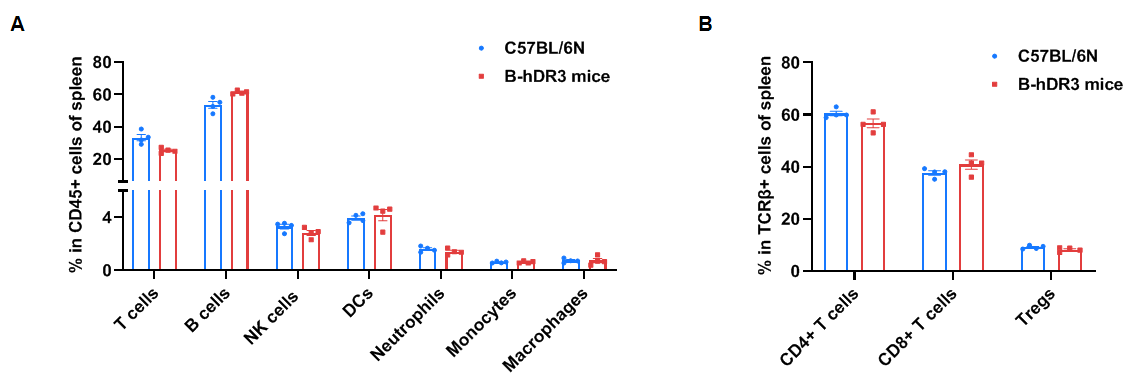
Frequency of leukocyte subpopulations in spleen by flow cytometry. Splenocytes were isolated from wild-type C57BL/6N mice (+/+) (female, n=4, 7-week-old) and homozygous B-hDR3 mice(H/H) (female, n=4, 7-week-old). A. Flow cytometry analysis of the splenocytes was performed to assess the frequency of leukocyte subpopulations. B. Frequency of T cell subpopulations. Percentages of T cells, B cells, NK cells, dendritic cells, neutrophils, monocytes, macrophages, CD4+ T cells, CD8+ T cells and Tregs in B-hDR3 mice were similar to those in C57BL/6N mice, demonstrating that humanization of DR3 does not change the frequency or distribution of these cell types in spleen. Values are expressed as mean ± SEM.

Frequency of leukocyte subpopulations in blood by flow cytometry. Blood cells were isolated from wild-type C57BL/6N mice (+/+) (female, n=4, 7-week-old) and homozygous B-hDR3 mice(H/H) (female, n=4, 7-week-old). A. Flow cytometry analysis of the blood was performed to assess the frequency of leukocyte subpopulations. B. Frequency of T cell subpopulations. Percentages of T cells, B cells, NK cells, dendritic cells, neutrophils, monocytes, macrophages, CD4+ T cells, CD8+ T cells and Tregs in B-hDR3 mice were similar to those in C57BL/6N mice, demonstrating that humanization of DR3 does not change the frequency or distribution of these cell types in blood. Values are expressed as mean ± SEM.

Frequency of leukocyte subpopulations in lymph nodes by flow cytometry. Lymph nodes cells were isolated from wild-type C57BL/6N mice (+/+) (female, n=4, 7-week-old) and homozygous B-hDR3 mice(H/H) (female, n=4, 7-week-old). A. Flow cytometry analysis of the lymph nodes cells was performed to assess the frequency of leukocyte subpopulations. B. Frequency of T cell subpopulations. Percentages of T cells, B cells, NK cells, CD4+ T cells, CD8+ T cells and Tregs in B-hDR3 mice were similar to those in C57BL/6N mice. Values are expressed as mean ± SEM.